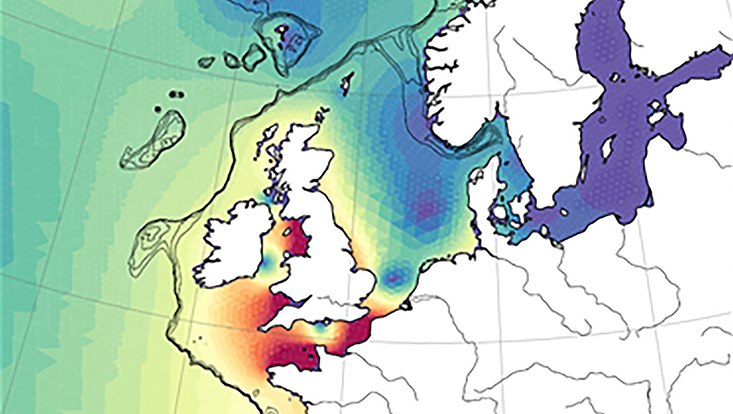How Boxes and Triangles Can Help Explore the Coastal Ocean
11 May 2023, by Moritz Mathis

Photo: Mathis et al. 2022
When it comes to research on global climate change, the coastal ocean is hardly considered – even though it can absorb and store CO2. The reason: our limited computing power. As a result, carbon cycling processes can only be represented on a macro scale. But the carbon content of the coastal ocean can vary widely at smaller scales, which requires a more detailed resolution to study the underlying mechanisms. My team and I from Universität Hamburg’s Cluster of Excellence for climate research “Climate, Climatic Change, and Society” (CLICCS) asked ourselves: How could these small-scale coastal processes be better integrated into climate predictions? And we found a solution.

Dr. Moritz Mathis
I don’t investigate climate processes only at the coast or in the lab; I also do it on my computer. My team and I have developed a software model that represents the Earth in the form of three-dimensional boxes. Each box contains a number of values, e.g. for the water temperature, oxygen concentration and carbon content. We also use certain laws of physics to define how the boxes’ sides could interact with neighboring boxes. For example, an adjacent box might be a land box or another ocean box.
The smaller the boxes are, the more computing power is needed – a thousand times the power of a standard laptop. I usually send my simulations to the supercomputer at the German Climate Computing Center in Hamburg’s Bundesstraße. For our model-based experiments, it takes up to two months to finish a simulation – depending on how many details and which timeframe it’s meant to cover.
But since even the supercomputer’s capacities are limited, the boxes are typically several kilometers on a side – too big to simulate small-scale processes in the coastal ocean. Until now, we’ve only been able to make boxes larger or smaller all at once in Earth system models. Alternatively, we could look at certain regions in more detail, but doing so meant giving up the global context. Climate research though often involves questions where we need this context to find an answer, while still taking a closer look at individual regions: with smaller boxes that span only a few hundred meters.
Accordingly, we developed a new model that allows us to explore the coastal ocean in detail without sacrificing the global context. And the best part: We can now define which areas are represented by large boxes and which by small ones – like the coastal ocean. We use comparatively large boxes for the open ocean, because the parameters presented vary less in magnitude, despite the kilometer-wide size. This approach makes the model highly efficient. Plus, there’s another change: Instead of square boxes, it uses triangular boxes of varying sizes. Not only are they better suited to more granular regional representation; they also cling to the terrain tighter; otherwise, they work just like quadratic boxes.
Thanks to our refined global coastal net, we can now seamlessly describe physical and biogeochemical processes from the coast to the open ocean – that’s a major leap forward. But we’ve already set new goals: Right now, the model is still limited to the ocean. We plan to expand it so that the land and atmosphere can also be explored in more detail. Theoretically, our model is ready to go, but we want to first put it through extensive testing so as to tap its full potential. The better we get to know the model, the more it can help us devise strategies to combat climate change – in the coastal ocean and beyond.
More information
Dr. Moritz Mathis’s main interest is in matter transport in the ocean. He is currently conducting research at the Helmholtz-Zentrum Hereon for Universität Hamburg’s Cluster of Excellence for climate research “Climate, Climatic Change, and Society” (CLICCS).
Publication: Mathis, M., et al. (2022). Seamless Integration of the Coastal Ocean in Global Marine Carbon Cycle Modeling. Journal of Advances in Modeling Earth Systems, 14(8). https://doi.org/10.1029/2021ms002789
Guest piece: This article was originally published in the Hamburger Abendblatt as part of our monthly series on climate research. All articles in the series


